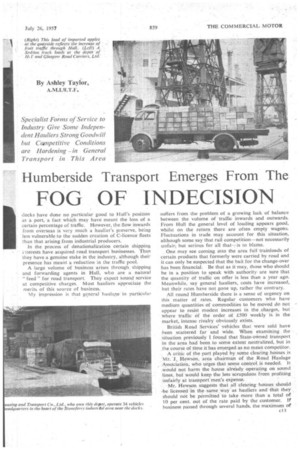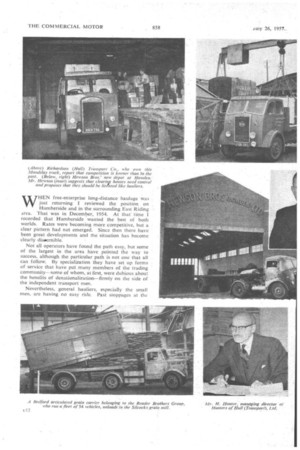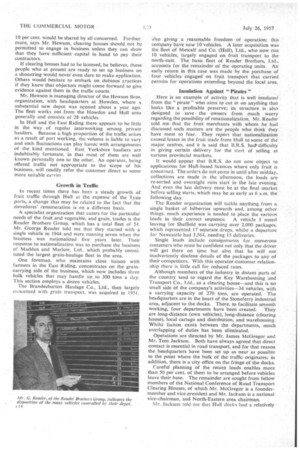Humberside Transport Emerges From The
Page 53

Page 52

Page 54

Page 55

If you've noticed an error in this article please click here to report it so we can fix it.
FOG OF INDECISION
Specialist Forms of Service to Industry Give Some-Independent Hauliers Strong Goodwill but Campetitive Conditions are Hardening -in General Transport in This Area By Ashley Taylor,
A.M.I.R.T.F.
WHEN free-enterprise long-distance haulage was just returning I reviewed the position on Humberside and in the surrounding East Riding arca. That was in December, 1954. At that time I recorded that Humberside wanted the best of both worlds. Rates were becoming more competitive, but a clear pattern had not emerged. Since then there have
been great developments and the situation has become clearly discernible.
Not all operators have found the path easy, but some of the largest in the area have pointed the way to success, although the particular path is not one that all can follow. By specialization they have set up forms of service that have put many members of the trading community—some of whom, at first, were dubious about the benefits of denationalization—firmly on the side of the independent transport men.
Nevertheless, general hauliers, especially the small men, are having no easy ride. Past stoppages at the docks have done no particular good to Hull's position as a port, a fact which may have meant the loss of a certain percentage of traffic. However, the flow inwards from overseas is very much a haulier's preserve, being less vulnerable to the sudden creation of C-licence fleets than that arising from industrial producers.
In the process of denationalization certain shipping lterests have acquired road transport businesses. Thus they have a genuine stake in the industry, although their presence has meant a reduction in the traffic pool.
A large volume of business arises through, shipping and forwarding agents in Hull, who are a natural " feed " for road transport. They expect Sound Service at competitive charges. Most hauliers appreciate the merits of this source of business.
My impression is that general haula„ge in particular suffers from the problem of a growing lack of balance between the volume of traffic inwards and outwards. From Hull the general level of loading appears good, whilst on the return there are often empty wagons. Fluctuations in trade may account for this situation, although some say that rail competition—not necessarily unfair, but serious for all that--is to blame.
One may see coming into the area full trainloads of certain products that formerly were carried by road and it can only be suspected that the bait for the change-over has been financial. Be that as it may, those who should be in a. position to speak With authority are sure that the quantity of traffic on offer is less than a year ago. Meanwhile, say general hauliers, costs have increased, but their rates have not gone up, rather the contrary.
All round Humberside there is a sense of urgency on this matter of rates. Regular customers who have medium quantities of commodities to be moved do not appear to resist modest increases in the charges, but where traffic of the order of £500 weekly is in the market, intense rivalry obviously exists.
British Road Services' vehicles that were sold have been scattered far and wide. When examining the situation previously I found that State-owned transport in the area had been to some extent neutralized, but in ,the course of time it has emerged as no mean competitor.
A critic of the part played by some clearing houses is Mr. J. Hewson, area chairman of the Road Haulage Association, who urges that some control is needed. It .would not harm the house already operating on sound lines, but would keep the less scrupulous from profiting unfairly at transport men's expense.
Mr. Fiewson suggests that all clearing houses should be licensed in the same way as hauliers and that they should not be permitted to take more than a total of 10 per cent. out of the rate paid by the customer. If business passed through several hands, the maximum of 10 per cent. would be shared by all concerned. Furthermore, says Mr. Hewson, clearing houses should not be permitted to engage in business unless they can show that they have sufficient capital in hand to pay their contractors.
If clearing houses had to be licensed, he believes, those people who at present are ready to set up business on a shoestring would never even dare to make application. Others would hesitate to embark on dubious Fractices if they knew that objectors might come forward to give evidence against them in the traffic courts.
Mr. Hewson is managing director of the Hewson Bros. organization, with headquarters at Howden, where a substantial new depot was opened about a year ago. The fleet works out from the Howden and Hull area generally and Consists of 28 vehicles.
In Hull and the East Riding there appears to be little in the way of regular interworking among private hauliers. Because a high proportion of the traffic arises as a result of port working, the volume is liable to vary and such fluctuations can play havoc with arrangements of the kind mentioned. East Yorkshire hauliers are indubitably fortunate, in that most of them are well known personally one to the other. An operator, being. offered traffic not appropriate to the scope of his business, will readily refer the customer direct to some more suitable carrier.
Growth in Traffic
In recent times there has been a steady growth of fruit traffic through Hull at the expense of the Tyne ports, a change that may be related to the fact that the stevedores' remuneration is on a different basis.
A specialist organization that caters for the particular needs of the fruit and vegetable, and grain, trades is the Reader Brothers Group, which has a total fleet of 54. Mr. George Reader told me that they started with a single vehicle in 1944 and were running seven when the business was nationalized five years later_ Their response to nationalization was to purchase the business of Maddox and Marlow. Ltd.. which probably constituted the largest grain-haulage fleet in the area.
One foreman, who maintains close liaison with farmers in the East Riding, concentrates on the graincarrying side.of the business, which now includes three bulk vehicles that may handle up to 300 tons a day. This section employs a dozen vehicles.
The Brandesburton Haulage Co., Ltd., then largely concerned with grain transport, was acquired in 1951, also giving a reasonable freedom of operation; this company have now 10 vehicles. A later acquisition was the fleet of Metcalf and Co. (Hull), Ltd., who now run 10 vehicles, largely engaged on fruit transport to the north-east. The basic fleet of Reader Brothers, Ltd., accounts for the remainder of the operating units. An early, return in this case was made by the purchase of four vehicles engaged on fruit transport that carried permits for operations extending beyond the local area.
Insulation Against " Pirates "
Here is an example of activity that is well insulated from the " pirate " who aims to cut in on anything that looks like a profitable preserve; its structure is also designed to save the owners from much worry regarding the possibility of renationalization. Mr. Reader told me that the fruit merchants with whom he had discussed such matters are the people who think they have most to fear. They report that nationalization caused losses in the fruit trade from Hull to some of the major centres, and it is said that B.R.S. had•clifficulty in giving certain delivery for the start of selling at various provincial markets.
It would appear that B.R.S. do not now object to applications for Hull-based licences where only fruit is concerned. The orders do not come in until after midday, collections are made in the afternoon, the loads are re-sorted and overnight runs start in the late evening. And even the last delivery must be at the final market before selling starts, which may be as early as 6 a.m. the following day.
The Reader organization will tackle anything from a single basket of bilberries upwards and, among other things, much experience is needed to place the various loads in their correct sequence. A vehicle 1 noted leaving for Sheffield was carrying over 2,000 packages, which represented 17 separate drops, whilst a departure for Newcastle had 3,564, needing 15 deliveries.
Single loads include consignments for numerous customers who must be confident not only that the driver will get there on time but also that he will not inadvertently disclose details of the packages to any of their competitors. With this operator-customer relationship there is little call for reduced rates.
Although members of the industry in distant parts of the country tend to regard the Key Warehousing and Transport Co., Ltd„ as a clearing house—and this is no small side of the company's activities-34 vehicles, with a carrying capacity of 270 tons, are operated. The headquarters are in the heart of the Stoneferry industrial area, adjacent to the docks. There, to facilitate smooth working, four departments have been created. They are long-distance (own vehicles), long-distance (clearing house), local cartage and distribution, and warehousing. Whilst liaison exists between the departments, much overlapping of duties has been eliminated.
Operations are directed by Mr. James McGregor and Mr. Tom Jackson. Both have always agreed that direct contact is essential in road transport, and for that reason the headquarters have been set up as near as possible to the point where the bulk of the traffic originates; in addition, there is a city office on the fringe of the docks.
Careful planning of the return loads enables more than 50 per cent. of them to be arranged before vehicles leave their-base. The remainder are sought from fellow members of the National Conference of Road Transport Clearing Houses, of which Mr. McGregor is a foundermember and vice-president and Mr. Jackson is a national vice-chairman, and North-Eastern area chairman.
Mr. Jackson told me that Hull docks had a relatively good record in respect of transport delays, but, to reduce such interruptions of service to a minimum, the proportimi of articulated vehicles (all with the Scammetl coupling) had been built up until they comprised half the fleet. All local vehicles were fitted with radio-telephones some three years ago.
Acceptance of goods direct from steamer to road vehicle, and vice versa, is more common today than in earlier years, so that the operation of quickly detachable articulated outfits has been a big advantage. Mr. Jackson said that frequently, in addition to normal commitments, the Key fleet was requested to move between 200 and 400 tons from 'steamer, for which purpose their facilities were now well adapted. The main loading bay at the Stoneferry headquarters is unusual in that a sloping deck has been made to normal vehicle platform height, leaving the ikhole of the warehouses and bay without changes in level.
Transport from HuMberside to Scotland has been the speciality of Mr. J. L. Dunn ever sitice 1933. Mr. Dunn's business was nationalized on January 1, 1950, and for 18 months he was a depot superintendent for B.R.S., who were then running a trunk service to Scotland. After a while he parted company with the Statecontrolled organization. He re-entered the long-distance haulage business at the beginning of Jdne, 1954.
Now Hull and Glasgow Road Carriers, Ltd., have 12 lorries running on their trunk route and three on collection and delivery; this is another cpse where intending new competitors must have difficulty in matching the existing facilities.
Speedy Service
Not only is there a 12-hour door-to-door service between Humberside and Scotland, but any quantity down to the odd hundredweight is carried. Regularly containers of biscuits are lifted from the factory in Glasgow at 4 p.m. or later. They are transferred to the manufacturer's van in Hull at 8 a.m. the following day.
When organized in this thorough-going manner the speed of delivery offers something better than the C-licensee could achieve for himself, so that the Hull and Glasgow service is often employed by ancillary operators for their Scottish runs. To kill delays and cope with emergencies, a radio-telephone system is employed at the terminal points, all vehicles, both trunk and collection, being so fitted. Covering a radius of 40 miles this system takes in Grimsby and is frequently instrumental in obviating lengthy detours that would be necessary in the course of a return to Hull after working at Grimsby or elsewhere on the southern side of the Humber.
Mr. Dunn regards trunk-route consignments of over 6 tons as the most vulnerable to the rate-cutter and points out that a service that is willing to accept lots both big and small is reasonably sure of a good rate overall. Graphs in Mr. Dunn's office show the levels of loading are remarkably consistent when the northward run is compared with the southward. By liaison with Scottish hauliers connections are offered to all parts of Scotland.
A prominent figure in Hull transport circles is Mr. Harold Hunter, managing director of Hunters of Hull (Transport), Ltd. The Hunter organization has a total fleet of 62 and Mr. Hunter tells me that it is kept fully occupied, although fluctua tions in trade have affected hiring figures to some extent.
Goods are carried all over the country and a steadily increasing number of articulated vehicles is being put into operation. Three years ago extensive premises in Holmes Street were acquired and modernized. Both ground and first floor are devoted to warehousing, hundreds of varieties of foodstuffs being kept in store.
They are hauled from the food factories to the Hull warehouse and distributed to retailers.
Another specialist is the Richardson (Hull) Transport Co. (registered as Pickering Road Haulage, Ltd.), which entered the lists in the early 'thirties and until nationalization wasalmost wholly devoted to serving the Hull-London route. Nationalization took place on June 2, 1949, but both Mr. A. M. Drury and Mr. F. Richardson—working on behalf of B.R.S.—continued to be associated with the London service.
In April, 1954, their tender for their old depot was successful and they are now running 27 vehicles, mostly of the larger type." There are regularly 16 on trunk service, eight each way between London and Hull. In addition to some collection and delivery machines there are four lorries on general work, including a weekly run to Southampton.
Sharper Competition Apart from purely transport activities, warehousing is provided, with distribution throughout the East Riding. Competition,.reports Mr. Drury, is ,sharper than in the immediate past and, although most customers have been fair, an air of uncertainty has clouded the rates situation during the !last year. As. Mr. Richardson points out, cutters in general often bring prices down for the recognized hauliers, but the latter, if they are keen, still get the traffic. At the same time, it has not been• unknown for the ,rat-cutter to end up by ac,cepting traffic at the cut rate,,,less a percentage, from the very man whom. he has _tried to eliminate. Among -the numerous small operators there appear to have been relatively few changes of ownership over the past two years, but conversations I have had with many members of the industry suggest that, although they are surviving, the " little men " are not making big money. Recent rises in costs must have left the profit margins perilously narrow in many cases. It is among the small general hauliers that the greatest changes appear most likely to occur in the immediate future.








































































































